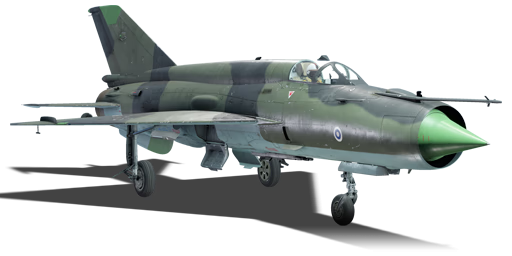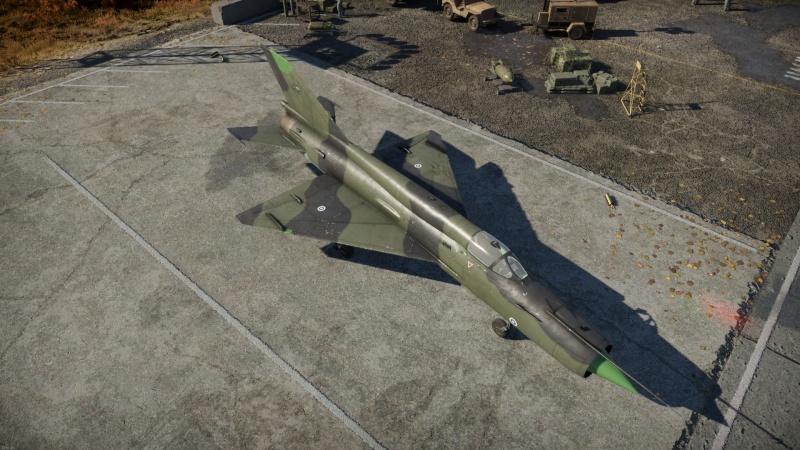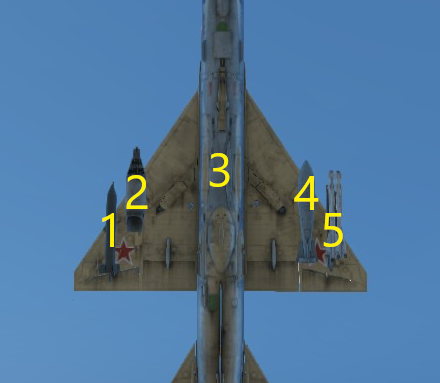MiG-21bis (Sweden)
Contents
Description
The ▄MiG-21bis is a rank VII Swedish jet fighter with a battle rating of 11.0 (AB/RB/SB). It was introduced in Update "Fire and Ice".
The MiG-21bis is the ultimate development of the MiG-21. It looks roughly the same as the MiG-21SMT and MiG-21MF, both third-generation MiG-21 models with search radars, internal GSh-23 cannons, and pronounced fuselage spines. The main improvement in the MiG-21bis is a new R-25 engine with an emergency afterburner stage outputting more than 9,000 kgf of thrust in optimal conditions, granting excellent acceleration and climb rate for a single-engine fighter. The armament remains similar to the MiG-21SMT, but has the option of new R-13M1 infrared missiles similar to the AIM-9G and can carry an additional two R-60s for a maximum of six. Although the MiG-21bis has weak BVR capabilities and lacks the dogfight-tuned airframe of the J-7E, it can still be a powerhouse in close combat for pilots who use its strong engine power, good missile capacity, and ability to pull high AoA turns.
General info
Flight performance
The MiG-21bis has absolutely phenomenal acceleration and high-speed performance making it one of the highest-performing aircraft in the game. Firstly, the aircraft is quite fast, being able to reach 1,365 km/h IAS on the deck (at low altitudes) before its wings rip - this means that it is usually capable of outrunning most enemies at its rank, such as Phantoms and the Mirage, with the exception of the F-104 Starfighters which can outrun the MiG-21bis by a small margin. Secondly, the aircraft has the fastest overall acceleration of any aircraft in the game, meaning that it can reach its top speed quickly. However, like all other MiG-21s, the MiG-21bis cannot turn well and tends to bleed speed at an alarming rate during turns. Extended dogfights should therefore be avoided, as the MiG-21bis will often end up on the losing side.
The MiG-21bis has a strong set of control surfaces including an all-moving tail, which keeps the aircraft responsive up to high speeds (>1,300 km/h). However, be aware that the aircraft has two limiting structural factors: the wings' rip speed and structural G limit. Wings will rip at 1,365 km/h IAS, a speed the plane can reach relatively quickly given its phenomenal acceleration. The structural limit of 13G means stronger turns should thus be avoided as there is a risk that they will rip the aircraft's wings.
| Characteristics | Max speed (km/h at _,___ m) |
Max altitude (metres) |
Turn time (seconds) |
Rate of climb (metres/second) |
Take-off run (metres) | |||
|---|---|---|---|---|---|---|---|---|
| AB | RB | AB | RB | AB | RB | |||
| Stock | ___ | ___ | 16000 | __._ | __._ | __._ | __._ | ___ |
| Upgraded | ___ | ___ | __._ | __._ | __._ | __._ | ||
Details
| Features | |||||
|---|---|---|---|---|---|
| Combat flaps | Take-off flaps | Landing flaps | Air brakes | Arrestor gear | Drogue chute |
| _ | _ | _ | _ | _ | _ |
| Limits | ||||||
|---|---|---|---|---|---|---|
| Wings (km/h) | Gear (km/h) | Flaps (km/h) | Max Static G | |||
| Combat | Take-off | Landing | + | - | ||
| 1365 | 700 | ___ | ___ | ___ | ~__ | ~__ |
| Optimal velocities (km/h) | |||
|---|---|---|---|
| Ailerons | Rudder | Elevators | Radiator |
| < ___ | < ___ | < ___ | N/A |
Engine performance
| Engine | Aircraft mass | |||||
|---|---|---|---|---|---|---|
| Engine name | Number | Basic mass | Wing loading (full fuel) | |||
| _____ | _ | _,___ kg | ___ kg/m2 | |||
| Engine characteristics | Mass with fuel (no weapons load) | Max Gross Weight | ||||
| Weight (each) | Type | _m fuel | __m fuel | __m fuel | ||
| ___ kg | ___ | _,___ kg | _,___ kg | _,___ kg | _,___ kg | |
| Maximum engine thrust @ 0 m (RB/SB) | Thrust to weight ratio @ 0 m (___%/WEP) | |||||
| Condition | 100% | ___%/WEP | _m fuel | __m fuel | __m fuel | MGW |
| Stationary | ___ kgf | ___ kgf | _.__ | _.__ | _.__ | _.__ |
| Optimal | ___ kgf (_ km/h) |
___ kgf (_ km/h) |
_.__ | _.__ | _.__ | _.__ |
Survivability and armour
- 60 mm bulletproof glass - armoured windscreen
- 10 mm steel - bulkhead behind pilot
- Engine and fuel tanks take up most of the fuselage area behind the cockpit
Modifications and economy
Armaments
Offensive armament
The MiG-21bis (Sweden) is armed with:
- A choice between two presets:
- 1 x 23 mm GSh-23L cannon, belly-mounted (250 rpg)
- 1 x 23 mm GSh-23L cannon + 64 x countermeasures
Suspended armament
The MiG-21bis (Sweden) can be outfitted with the following ordnance presets:
- Without load
- 2 x R-13M1 missiles
- 4 x R-3S missiles
- 4 x R-3R missiles
- 4 x R-13M1 missiles
- 4 x R-60 missiles
- 6 x R-60 missiles
- 64 x S-5K rockets (4 x 16-rocket pods)
- 64 x S-5K rockets (2 x 32-rocket pods)
Custom loadout options
| 1 | 2 | 3 | 4 | ||
|---|---|---|---|---|---|
| S-5K rockets | 16 | 16, 32 | 16, 32 | 16 | |
| R-3R missiles | 1 | 1 | 1 | 1 | |
| R-3S missiles | 1 | 1 | 1 | 1 | |
| R-13M1 missiles | 1 | 1 | 1 | 1 | |
| R-60 missiles | 1, 2 | 1 | 1 | 1, 2 |
Usage in battles
The MiG-21bis is fairly manoeuvrable at high speeds and since it accelerates quickly and climbs extremely well, it works well as an interceptor (take off, reach around 1,000 km/h, burst climb at a 20-25 degree angle up to 6,000 or 7,000 m and fire on anything that can be sighted) but this method has some risks.
First, the MiG-21bis is prone being hit by a Matra R530E or the infamous AIM-7 SARHMs (Semi Active Radar Homing Missiles) that can easily shoot the MiG-21bis down since the plane becomes a brick at higher altitudes. And sometimes, even if the MiG-21bis succeeds in its interception objective, some enemies will fly in a different path, so they'll easily sneak up behind the MiG-21bis and take it down with missiles if it is high and slow enough.
The second way to play this plane is to fly at lower altitudes (below 2,000 m) and engage any targets that are encountered, the risk here is that the MiG-21bis is left vulnerable to high-flying enemies that, again, can easily sneak up and take the MiG-21bis down, so pay attention to the surroundings and avoid getting an IR missile shot up into the engine.
The third, and probably safest, way to play the MiG-21bis is to flank around the main fighting area. Side-climb up to around 4-5 kilometres in the air, making sure to avoid the frequented flight paths so the MiG-21bis does not appear on their radar (additionally, turn off the MiG-21bis' radar during this climb so that the enemies' radar-warning receiver does not pick up the MiG-21's radar as well). Idle around the sides until the main body of the enemy team is spotted and then begin turning towards the battlefield to begin engaging targets. As the MiG-21bis returns, keep an eye for any enemy planes that have a similar idea of flanking around. This scenario usually compose of only one enemy fighter climbing up, which a skilled MiG-21bis pilot can begin engaging in their favor if they have a height advantage. However, if two fighters appears, it is best to break off and move towards the vicinity of allies to help engage.
A more risky but rewarding playstyle is to use (2xR-13M-1 and 4xR-60) or (4xR-13M-1) and take advantage of MiG-21's 225 m/s climb rate, which in theory, is superior to even the Phantom FG.1 and FGR.2. Radars on most jets can scan ~15 degrees above the horizontal, and by climbing at Mach 0.90-0.95, it is possible to "fly above the radar" and remain undetected at BVR ranges. At high altitudes, the R-13 can be launched at 3 km in a chase and even farther in a dive against lower targets. Although the MiG-21 has a substantial advantage in transonic manoeuvrability, the MiG-21's delta wings cause significant energy bleed in turns as mentioned above. Making high-speed diving attacks is certainly a valid tactic, and fighting from high altitude downwards makes situational awareness easier as most enemies will be at lower altitudes rather than in all directions. This playstyle is most suitable for principled Phantom pilots who are accustomed to maintaining a high energy state.
Enemies worth noting:
- Phantoms, particularly F-4E and EJ models: these should be the MiG-21bis' priority targets, F-4Es and F-4EJs are well-known for being extremely versatile and dangerous (even sometimes referred to as the best top tier jets in the game). These planes accelerate quickly, can wield the dangerous AIM-9J AAMs that are able to pull 20 Gs of overload and can hit targets up to 3 km of range, have access to a large amount of flares and have responsive flight controls. However, a lot of Phantom pilots are overconfident into their planes and will often jump into a dogfight with the MiG-21bis, which is a terrible idea for Phantom pilots. The motto "a slow jet is a dead jet" rings true for most situations, but the MiG-21bis has an ace up its sleeve against Phantoms: better low and high speed manoeuvrability that can sometimes match the Phantom's turn rate! So if a Phantom attempts to dogfight the MiG-21bis, take up the challenge as it'll most likely end up with the Phantom pilots losing. However, only do so if there are allies nearby or if there aren't any enemies nearby or the MiG-21bis may end up getting taken out unexpectedly.
- The Mirage IIIC and the J35D Draken: These planes are also serious foes since they out turn everything at their BR (keep in mind that the J35D Draken is more manoeuvrable than the Mirage) so dogfighting them is a death sentence. They're also able to wield deadly missiles, the Draken wields the Swedish license built AIM-9P3s known as RB24Js and the Mirage has access to the extremely effective Matra R550 Magic 1 that pulls 30 Gs and has a higher top speed than other IR guided missiles. The best thing to do against these planes is to do a zoom-climb to bleed their speed since they have a lower thrust-to-weight ratio than the MiG-21bis and then do oblique turns since they both bleed a ton of speed when turning and have a lower acceleration than the MiG-21bis does. And if they try to fire a missile at the MiG-21bis? Don't worry, pop flares, turn off afterburner, and pull hard.
Pros and cons
Pros:
- Impressive climb rate of 225 m/s, making it one of the best climbers
- Increased flight performance compared to earlier MiG-21s
- Excels against both aerial and ground targets
- Has access to flares that are fired downwards, which means that missiles can be more easily evaded
- Stunning acceleration
- Excellent energy retention
- Can wield six R-60s
- Huge thrust to weight ratio
Cons:
- As all MiG-21s, it tends to bleed speed in turns, though not as much, thanks to the improved engine
- Vicious rudder lock at speeds above 700 km/h, can be frustrating when trying to get guns on target
- Pretty bad low speed manoeuvrability
- Doesn't respond well to wing damage - if a wingtip is lost, landing this plane will be very difficult, and if a wing is lost, the plane should be considered as lost
History
By the late 1960s, the Soviet high command sought to increase the effectiveness of the MiG-21 jet fighter, especially at lower altitudes, while at the same time knowing that this could only be achieved by developing a more powerful engine for it. As a result, in 1971, the order to develop what would essentially become the MiG-21bis was issued by the Soviet high command.
As both the power plant manufacturer - Tumansky - as well as the MiG aircraft design bureau were already working on improvements, this order only officially recognized their work, and as a result, by 1972 the MiG-21bis was ready.
Unlike preceding variants, the MiG-21bis managed to strike a balance between performance and endurance. Additionally, the aircraft was fitted with an improved radar and a systems monitor, which made maintenance substantially easier. Furthermore, the maximum number of missiles the aircraft could carry was increased to six while it also received the option to carry the new R-13M air-to-air missile with increased range, higher G-loading and better seeker tracking over the preceding R-3S. Very manoeuvrable R-60 missiles can be carried as well.
The first MiG-21bis was constructed in 1972 and was adopted into service in the same year. Well over 2,200 units of the MiG-21bis would be manufactured, including licence-built versions. The MiG-21bis was one of the most widely produced variants of the aircraft and saw widespread use with numerous operators around the globe. In fact, some modernized modifications are still in combat use today.
Media
Excellent additions to the article would be video guides, screenshots from the game, and photos.
See also
Links to the articles on the War Thunder Wiki that you think will be useful for the reader, for example:
- reference to the series of the aircraft;
- links to approximate analogues of other nations and research trees.
External links
Paste links to sources and external resources, such as:
- topic on the official game forum;
- other literature.
| Sweden jet aircraft | |
|---|---|
| Fighters | J21RA |
| J29A · A29B · J29D · J29F | |
| J32B | |
| J34 | |
| J35A · J35D | |
| JA37C · JA37D · JA37DI · JA37DI F21 | |
| JAS39A · JAS39C | |
| Strike aircraft | A21RB |
| A32A · A32A Röd Adam | |
| A28B | |
| AJ37 · AJS37 | |
| SK60B · SAAB-105G | |
| Export | SAAB-105OE |
| Finland | ▄Vampire FB 52A · ▄MiG-21bis · Saab J35XS |






